TOPICS ON THIS PAGE
Regular dental exams are an important part of maintaining your oral health. During your regular exam, we will:

Your regular exam takes about 45 minutes. Each regular exam includes a detailed teeth cleaning, in which we will clean, polish, and rinse your teeth to remove any tartar and plaque that have built up on the tooth’s surface.
Visiting our office every six months gives you the chance to talk to the dentist about any questions you may have about your oral health. It also gives us the best chance of spotting and treating dental issues before they get worse. Regular exams are offered by appointment only, so please contact our Marietta practice today to schedule your next dental exam and teeth cleaning.
 Bonding is a cosmetic dental procedure in which a substance is applied to your tooth to fill in a chip, improve the look of crooked teeth or lighten discolored teeth.
Bonding is a cosmetic dental procedure in which a substance is applied to your tooth to fill in a chip, improve the look of crooked teeth or lighten discolored teeth.
After your dentist has color-matched the material to your tooth color, the material “bonds” with your tooth, creating a natural look. This bonding material can also be used in place of silver amalgam fillings as it is much less noticeable due to its light color.
Bonding can be used as a fast, more affordable alternative to cosmetic treatments such as dental veneers. The resin used for dental bonding is not as strong or stain-resistant as porcelain, however, so it’s only recommended for use in small areas.
 A bridge is so-called as it literally bridges the gap between missing teeth, replacing them with natural-looking artificial teeth. This dental device can be made from a variety of materials such as gold or porcelain and is held in place by the surrounding teeth.
A bridge is so-called as it literally bridges the gap between missing teeth, replacing them with natural-looking artificial teeth. This dental device can be made from a variety of materials such as gold or porcelain and is held in place by the surrounding teeth.
As well as replacing missing teeth, a bridge also supports the shape of your face, keeps existing teeth from moving, improves your ability to eat and speak and evens out the force of your bite.
The success of any bridge depends on its foundation: the other teeth, gums, or bone to which it is attached. Therefore, it’s very important to keep your existing teeth, gums, and jaw healthy and strong.
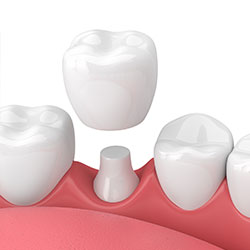 Crowns are a restorative procedure used to improve your tooth’s shape or to strengthen a tooth. Crowns are most often used for teeth that are broken, worn, or have portions destroyed by tooth decay.
Crowns are a restorative procedure used to improve your tooth’s shape or to strengthen a tooth. Crowns are most often used for teeth that are broken, worn, or have portions destroyed by tooth decay.
A crown is a “cap” cemented onto an existing tooth that usually covers the portion of your tooth above the gum line. In effect, the crown becomes your tooth’s new outer surface. Crowns can be made of porcelain, metal, or both. Porcelain crowns are more popular as they look very similar to real teeth and are also very strong.
If your tooth is too damaged or decayed to hold a filling, a crown or partial crown (also called an onlay) can be custom made for you. Your Marietta dentist will take an impression of your teeth and the crown will be sculpted to fit and function like a regular tooth.

Dentures are natural-looking replacement teeth that are removable. There are two types of dentures: full and partial. Full dentures are given to patients when all of the natural teeth have been removed. Partial dentures are attached to a metal frame that is connected to your natural teeth and are used to fill in where permanent teeth have been removed. Just like natural teeth, dentures need to be properly cared for. Use a gentle cleanser to brush your dentures, always keep them moist when they’re not in use, and be sure to keep your tongue and gums clean as well.
Yes, you may have heard them referred to as “false teeth” in the past but they’re the same thing – removable prosthetic or artificial teeth designed to look like natural teeth.
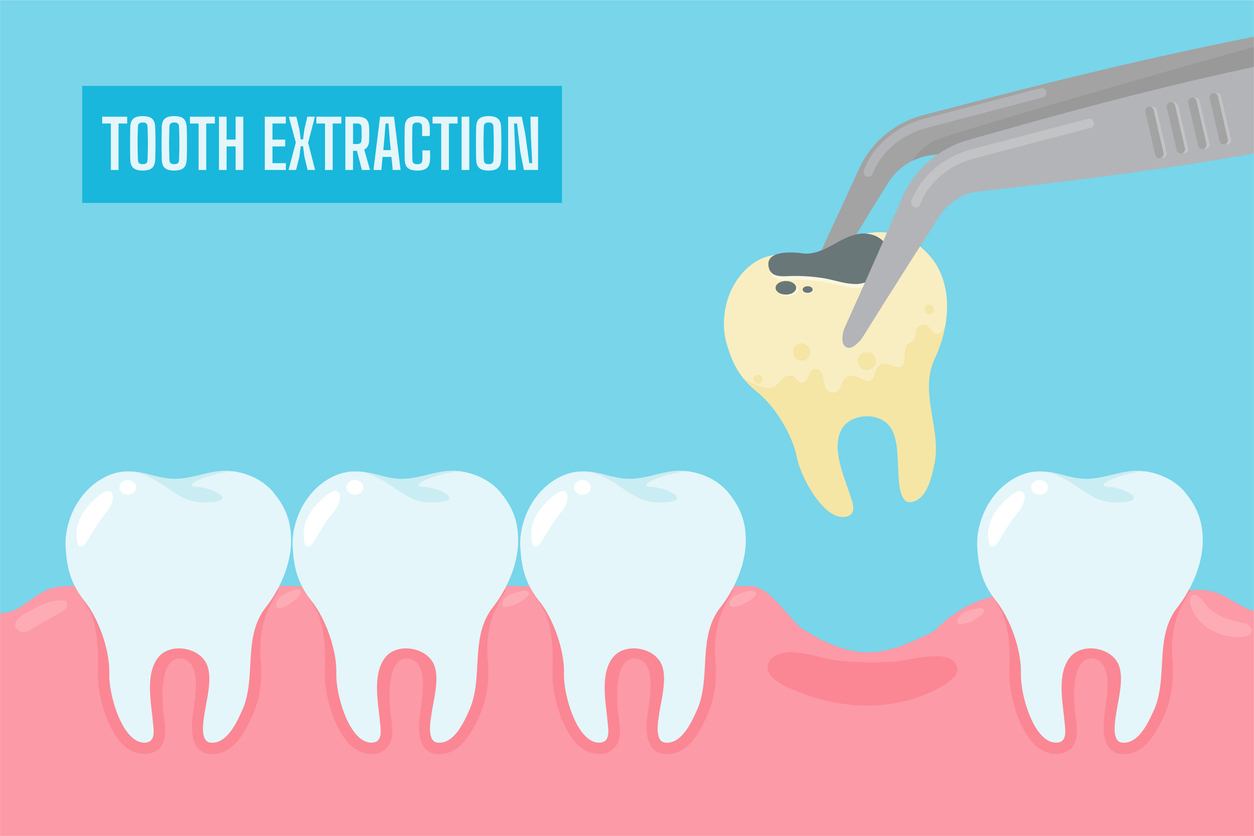 There are several reasons when a tooth extraction or removal is necessary, whether it’s decayed, damaged, misshapen or blocking a permanent tooth from erupting. Infection, wisdom tooth issues or removal for orthodontic reasons are also times this procedure will be carried out.
There are several reasons when a tooth extraction or removal is necessary, whether it’s decayed, damaged, misshapen or blocking a permanent tooth from erupting. Infection, wisdom tooth issues or removal for orthodontic reasons are also times this procedure will be carried out.
Tooth extraction is a common dental procedure that is usually quick and straightforward but you should let your dentist know if you are particularly anxious or if you have any sedation preferences.
Once a tooth has been removed, neighboring teeth may shift, causing problems with chewing or with your jaw joint function. To avoid these complications, your dentist may recommend that you replace the extracted tooth.
 Traditional dental restoratives, or fillings, are most often made of silver amalgam. This is a very strong and durable substance which makes it ideal for withstanding the bite forces found in the back of the mouth.
Traditional dental restoratives, or fillings, are most often made of silver amalgam. This is a very strong and durable substance which makes it ideal for withstanding the bite forces found in the back of the mouth.
Newer dental fillings include ceramic and plastic compounds that mimic the appearance of natural teeth. These compounds, often called composite resins, are usually used on the front teeth where they won’t be noticeable, but they can also be used on the back teeth depending on the location and extent of the tooth decay.
There are two different kinds of fillings: direct and indirect. Direct fillings are fillings placed into a prepared cavity in a single visit. They include silver amalgam, glass ionomers, resin ionomers, and composite (resin) fillings. Indirect filling procedures generally require two or more visits. They include inlays, onlays, and veneers. They are used when a tooth has too much damage to support a regular filling but not enough to necessitate a crown.
 Fluoride is effective in preventing cavities and tooth decay and in preventing plaque from building up and hardening on the tooth’s surface. A fluoride treatment in your dentist’s office is a quick, painless and easy procedure, taking just a few minutes. After the treatment, patients may be asked not to rinse, eat, or drink for at least 30 minutes in order to allow the teeth to absorb the fluoride. Depending on your oral health or your doctor’s recommendation, you may be required to have a fluoride treatment every three, six, or 12 months.
Fluoride is effective in preventing cavities and tooth decay and in preventing plaque from building up and hardening on the tooth’s surface. A fluoride treatment in your dentist’s office is a quick, painless and easy procedure, taking just a few minutes. After the treatment, patients may be asked not to rinse, eat, or drink for at least 30 minutes in order to allow the teeth to absorb the fluoride. Depending on your oral health or your doctor’s recommendation, you may be required to have a fluoride treatment every three, six, or 12 months.
]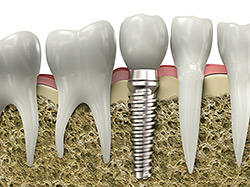 If you are missing teeth, it is crucial to replace them. Without all your teeth, chewing and eating can destabilize your bite and cause you discomfort. When teeth are missing, your mouth can shift and even cause your face to look older. Implants are a great way to replace your missing teeth, and if properly maintained, can last a lifetime!
If you are missing teeth, it is crucial to replace them. Without all your teeth, chewing and eating can destabilize your bite and cause you discomfort. When teeth are missing, your mouth can shift and even cause your face to look older. Implants are a great way to replace your missing teeth, and if properly maintained, can last a lifetime!
An implant is a new tooth made of metal and porcelain that looks just like your natural tooth. It’s composed of two main parts: one part is the titanium implant body that takes the place of the missing root, and the second part is the tooth-colored crown that is cemented on top of the implant. With our implant treatment procedure, you can smile confidently knowing no one will ever suspect you have a replacement tooth.
In addition to tooth replacement, implants may be used to anchor dentures, especially lower dentures that tend to shift when you talk or chew. For patients with removable partial dentures, implants can replace missing teeth so you have a more natural-looking smile.
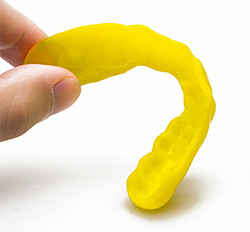 Whether you wear braces or not, protecting your smile while playing sports is essential. Mouthguards help protect your teeth and gums from injury. If you participate in any kind of full-contact sport, the American Dental Association recommends that you wear a mouthguard. Choosing the right mouthguard is essential. There are three basic types of mouthguards:
Whether you wear braces or not, protecting your smile while playing sports is essential. Mouthguards help protect your teeth and gums from injury. If you participate in any kind of full-contact sport, the American Dental Association recommends that you wear a mouthguard. Choosing the right mouthguard is essential. There are three basic types of mouthguards:
When you choose a mouthguard, be sure to pick one that is tear-resistant, comfortable and well-fitted for your mouth, easy to keep clean, and does not prevent you from breathing properly. A custom-made mouthguard from your dentist will give you the most comfortable and secure fit to protect your smile.
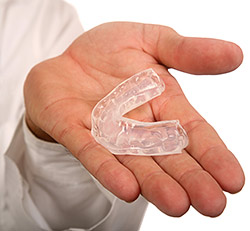 If you often wake up with jaw pain, earaches, or headaches, or if you find yourself clenching or grinding your teeth, you may have a common condition called “bruxism.” Many people do not even know that they grind their teeth, as it often occurs when you are sleeping. If not corrected, bruxism can lead to broken teeth, cracked teeth, or even tooth loss.
If you often wake up with jaw pain, earaches, or headaches, or if you find yourself clenching or grinding your teeth, you may have a common condition called “bruxism.” Many people do not even know that they grind their teeth, as it often occurs when you are sleeping. If not corrected, bruxism can lead to broken teeth, cracked teeth, or even tooth loss.
Luckily, there is an easy, non-invasive treatment for bruxism: nightguards. Nightguards are an easy way to prevent the wear and damage that teeth-grinding causes over time. Custom-made by your dentist from soft material to fit your teeth, a nightguard is inserted over your top or bottom arch and prevents contact with the opposing teeth, protecting them when you’re asleep.
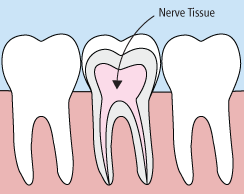 In the past, if you had a tooth with a diseased nerve, you’d probably lose that tooth. Today, with a special dental procedure called “root canal treatment,” your tooth can most likely be saved. When a tooth is cracked or has a deep cavity, bacteria can enter the pulp tissue and germs can cause an infection inside the tooth. If left untreated, an abscess may form. If the infected tissue is not removed, pain and swelling can result. This can not only injure your jawbones, but it is also detrimental to your overall health.
In the past, if you had a tooth with a diseased nerve, you’d probably lose that tooth. Today, with a special dental procedure called “root canal treatment,” your tooth can most likely be saved. When a tooth is cracked or has a deep cavity, bacteria can enter the pulp tissue and germs can cause an infection inside the tooth. If left untreated, an abscess may form. If the infected tissue is not removed, pain and swelling can result. This can not only injure your jawbones, but it is also detrimental to your overall health.
Root canal treatment involves one to three visits. During treatment, your general dentist or endodontist (a dentist who specializes in problems with the nerves of the teeth) removes the affected tissue. Next, the interior of the tooth will be cleaned and sealed. Finally, the tooth is filled with a dental composite. If your tooth has extensive decay, your doctor may suggest placing a crown to strengthen and protect the tooth from breaking. As long as you continue to care for your teeth and gums with regular brushing, flossing, and checkups, your restored tooth can last a lifetime.
 Sometimes brushing is not enough, especially when it comes to those hard-to-reach spots in your mouth. It is difficult for your toothbrush to get in-between the small cracks and grooves on your teeth. If left alone, those tiny areas can develop tooth decay. Sealants give your teeth extra protection against decay and help prevent cavities.
Sometimes brushing is not enough, especially when it comes to those hard-to-reach spots in your mouth. It is difficult for your toothbrush to get in-between the small cracks and grooves on your teeth. If left alone, those tiny areas can develop tooth decay. Sealants give your teeth extra protection against decay and help prevent cavities.
Dental sealants are plastic resins that bond and harden in the deep grooves on your tooth’s surface. When a tooth is sealed, the tiny grooves become smooth and are less likely to harbor plaque. With sealants, brushing your teeth becomes easier and more effective against tooth decay.
Sealants are typically applied to children’s teeth as a preventive measure against tooth decay after the permanent teeth have erupted. However, adults can also receive sealants on healthy teeth. This is a quick, painless and very common dental procedure.
Sealants last from three to five years, but it is fairly common to see adults with sealants still intact from their childhood. A dental sealant only provides protection when it is fully intact, so if your sealants come off, let your dentist know, and schedule an appointment for your teeth to be re-sealed.
You no longer need to hide your smile because of gaps, chips, stains, or misshapen teeth. With veneers, you can easily correct your teeth’s imperfections to help you have a more confident, beautiful smile. Veneers are natural in appearance, and they are a perfect option for patients wanting to make minor adjustments to the look and feel of their smile.
Veneers are thin, custom-made shells made from tooth-colored materials (such as porcelain), and they are designed to cover the front side of your teeth. To prepare for veneers, your doctor will create a unique model of your teeth. This model is sent to the dental technician to create your veneers. Before placing your new veneer, your doctor may need to conservatively prepare your tooth to achieve the desired aesthetic result.
With a dental veneer procedure, you’ll be pleased to see that they look like your natural teeth. While veneers are stain-resistant, your doctor may recommend that you avoid coffee, tea, red wine, and tobacco to maintain the beauty of your new smile.
 Wisdom teeth are types of molars found in the very back of your mouth. They usually appear in the late teens or early twenties, but may become impacted (fail to erupt) due to lack of room in the jaw or angle of entry. When a wisdom tooth is impacted, it may need to be removed. If it is not removed, you may develop gum tenderness, swelling, or even severe pain. Impacted wisdom teeth that are partially or fully erupted tend to be quite difficult to clean and are susceptible to tooth decay, recurring infections, and even gum disease.
Wisdom teeth are types of molars found in the very back of your mouth. They usually appear in the late teens or early twenties, but may become impacted (fail to erupt) due to lack of room in the jaw or angle of entry. When a wisdom tooth is impacted, it may need to be removed. If it is not removed, you may develop gum tenderness, swelling, or even severe pain. Impacted wisdom teeth that are partially or fully erupted tend to be quite difficult to clean and are susceptible to tooth decay, recurring infections, and even gum disease.
Wisdom teeth are typically removed in the late teens or early twenties because there is a greater chance that the teeth’s roots have not fully formed and the bone surrounding the teeth is less dense. These two factors can make extraction easier as well as shorten the recovery time.
Depending on the degree of difficulty related to the extraction procedure, healing time varies. Your dentist will share with you what to expect and provide instructions for a comfortable, efficient healing process.
Proudly serving patients in Marietta, Kennesaw and surrounding areas, Kenmar Dental looks forward to seeing you at your next appointment. Contact us today to schedule a visit, we’re looking forward to seeing you.